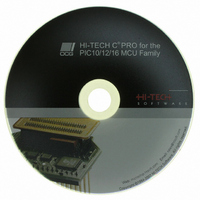SW500010 Microchip Technology, SW500010 Datasheet - Page 183

SW500010
Manufacturer Part Number
SW500010
Description
HI-TECH C PRO FOR PIC10/12/16
Manufacturer
Microchip Technology
Type
Compilerr
Series
PIC10/12/16r
Specifications of SW500010
Supported Families
PIC10, PIC12, PIC16
Core Architecture
PIC
Software Edition
Professional
Kit Contents
Software And Docs
Mcu Supported Families
PIC10/12/16
Tool Type
Compiler
Lead Free Status / RoHS Status
Not applicable / Not applicable
For Use With/related Products
PIC10, PIC12, PIC14, PIC16, PIC16E
Lead Free Status / Rohs Status
Lead free / RoHS Compliant
Other names
019P
778-1006
778-1006
778-1006
778-1006
- Current page: 183 of 502
- Download datasheet (3Mb)
Linker and Utilities
in the device’s native format. To facilitate this, the -ADDRESSING option is used. This option
takes exactly one parameter which configures the number of bytes contained per address location.
If for example a device’s program memory naturally used a 16-bit (2 byte) word-addressing format,
the option -ADDRESSING=2 will configure hexmate to interpret all command line address fields
as word addresses. The affect of this setting is global and all hexmate options will now interpret
addresses according to this setting. This option will allow specification of addressing modes from
one byte-per-address to four bytes-per-address.
5.15.1.4 -BREAK
This option takes a comma separated list of addresses. If any of these addresses are encountered
in the hex file, the current data record will conclude and a new data record will recommence from
the nominated address. This can be useful to use new data records to force a distinction between
functionally different areas of program space. Some hex file readers depend on this.
5.15.1.5 -CK
The -CK option is for calculating a checksum. The usage of this option is:
where:
-CK=start-end@destination[+offset][wWidth][tCode][gAlogithm]
Start and End specify the address range that the checksum will be calculated over.
Destination is the address where to store the checksum result. This value cannot be within the
range of calculation.
Offset is an optional initial value to add to the checksum result. Width is optional and specifies
the byte-width of the checksum result. Results can be calculated for byte-widths of 1 to 4
bytes. If a positive width is requested, the result will be stored in big-endian byte order. A
negative width will cause the result to be stored in little-endian byte order. If the width is left
unspecified, the result will be 2 bytes wide and stored in little-endian byte order.
Code is a hexadecimal code that will trail each byte in the checksum result. This can allow
each byte of the checksum result to be embedded within an instruction.
Algorithm is an integer to select which hexmate algorithm to use to calculate the checksum
result. A list of selectable algorithms are given in Table 5.10. If unspecified, the default
checksum algorithm used is 8 bit addition.
Hexmate
183
Related parts for SW500010
Image
Part Number
Description
Manufacturer
Datasheet
Request
R

Part Number:
Description:
Manufacturer:
Microchip Technology Inc.
Datasheet:

Part Number:
Description:
Manufacturer:
Microchip Technology Inc.
Datasheet:

Part Number:
Description:
Manufacturer:
Microchip Technology Inc.
Datasheet:

Part Number:
Description:
Manufacturer:
Microchip Technology Inc.
Datasheet:

Part Number:
Description:
Manufacturer:
Microchip Technology Inc.
Datasheet:

Part Number:
Description:
Manufacturer:
Microchip Technology Inc.
Datasheet:

Part Number:
Description:
Manufacturer:
Microchip Technology Inc.
Datasheet:

Part Number:
Description:
Manufacturer:
Microchip Technology Inc.
Datasheet:










